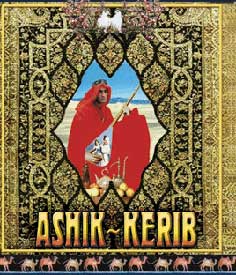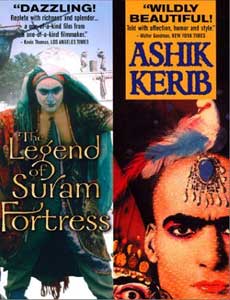 Available separately or on dvd as a double feature The Legend of Suram Fortress (Ambavi Suramis tsikhitsa, 1984) & Ashik Kerib (Ashugi Qaribi, 1988) are films wherein narrative is less important than visual impact.
Available separately or on dvd as a double feature The Legend of Suram Fortress (Ambavi Suramis tsikhitsa, 1984) & Ashik Kerib (Ashugi Qaribi, 1988) are films wherein narrative is less important than visual impact.
Both films have an identical arabesque look to them, & are also so retro they have the beauty & artifice of silent films, though in color. I'd've guessed they were from no later than the 1950s rather than 1980s, & don't known whether the retro look was an artistic choice to reflect the folkloric material or if Georgian-Armenian cinema is just naturally this old-fashioned. The acting in both films is stagy & unrealistic, so it is always like looking at the story from afar -- windows into an ancient time that never becomes immediate.
Director Sergei Parajanov spent the 1970s in the Russian Gulag for his refusal to make his films relevant to communism, though the official charges ranged from illegal money-changing to homosexuality. The severe governement harrassment meant he went fifteen years without making a film.
The Legend of Suram Fortress was his first film after his release. It is based on the folk tale of a youth plastered alive into the walls of a fortress so that it would not fall. One cannot help but think he was finally being relevant in recalling his own experience sealed away in the Gulag.
Young lovers are parted, the man promising to return, but he never does, falling in love elsewhere in the world & siring a son. His abandoned love wanders some while seeking him, but finally becomes a seer of an eerie mountain temple, & grows old there.
Emmissaries from afar come to her for advice on how to keep Suram Fortress from crumbling, & she describes a young man who should be sealed into the structure. This is the son of the man who abandoned her.
The young man voluntarily walled himself into the fortress in a very powerful climax, with the response of enthusiastic celebration that closes the film disturbing in its cultural strangeness & the revelers' delight in sacrifice.
Upon this slim tale we are given an impressionistic, often surrealistic, pictorial experience that is either modernist expressionism, or ancient mummury, with many still-life pillow-shots, rendering the film experience as more like looking at an exhibition of Persian miniatures. The look of the film is ornate & evocative of the Ottoman Empire or Sheherazade, though it is not a Moslem film per se & the religious-cultural content blends Eastern Orthodox & Islam in a manner that might find some parallel as a Felliniesque carnivale.
It is such a uniquely personal & fragmented approach to filmmaking that the result can be a tad inexcessible, but rewards patience.
 Ashik Kerib, Parajanov's final film, is also known as The Lovelorn Minstrel or The Hoary Legends of the Caucasus. Ashik Kerib, Parajanov's final film, is also known as The Lovelorn Minstrel or The Hoary Legends of the Caucasus.
It's based on a poem by Mikhail Lermontov written during his exile from Russia. Though Parajanov is by & large apolitical creating art for art's sake, his choice to adapt a legend through the intermediary of an exile's poem, after his own long period of persecution by the Soviets, certainly gives a second meaning to the hero's lovelorn misery.
To me Ashik Kerib was not as captivating as Suram Fortress, but perhaps this was only because I viewed it second too soon after watching Fortress. Ashik Kerib uses all the same visual ingredients as Suram Fortress & they are not as stunning a surprise the second time around. If I'd seen Ashik Kerib first perhaps it would've been Fortress that was less captivating, though I'd still assess Fortress even so the greater delight.
As with Fortress Parajanov seems to be creating Persian miniatures & Orthodox illuminated manuscripts or paintings of Armenia & Georgia & giving these icons & treasures cinematic motion. But to great extent they remain two-dimensional like a coffeetable art book of reproductions.
The story again is thin, an excuse for the visuals: A poor youth is turned away by the wealthy father of the beautiful young woman he loves & who loves him. There proceeds a journey of sorrow given mystical & symbolist components so heavyhanded that the narrative vanishes altogether in favor of dance, song, & images out of medieval paintings. The effect is of an Islamic MTV music video recovered from three or four hundred years ago.
Both films are more like works of pictorial art in a museum than film experiences & have to be approached very differently than when viewing films with stronger narrative drives or characterizations or action. These exist largely for their own beauty & much less for the stories they have to tell.
I was not personally so bowled over that I am apt soon to ferret out more of Parajanov's films, but it is nevertheless obvioius he was a masterful & unique filmmaker.
copyright © by Paghat the Ratgirl
|

